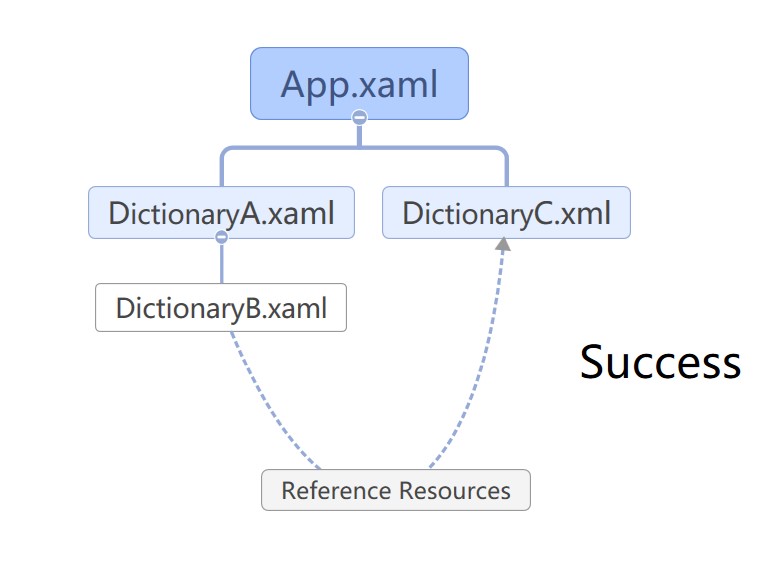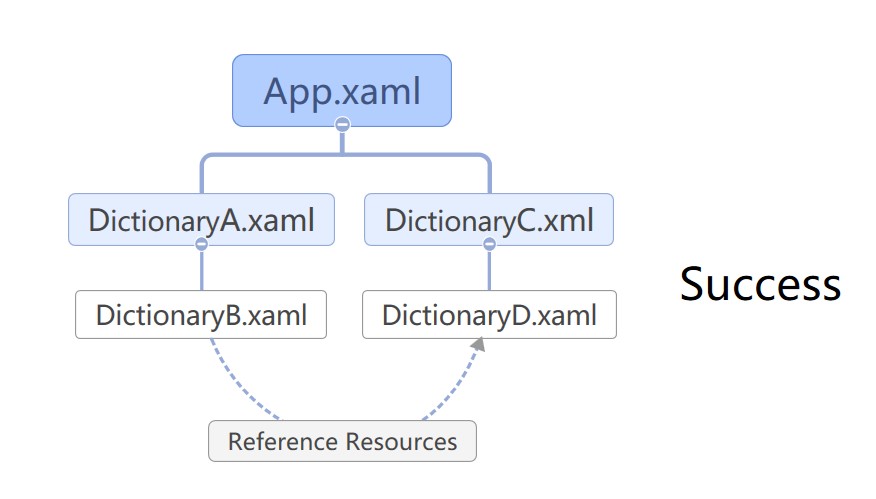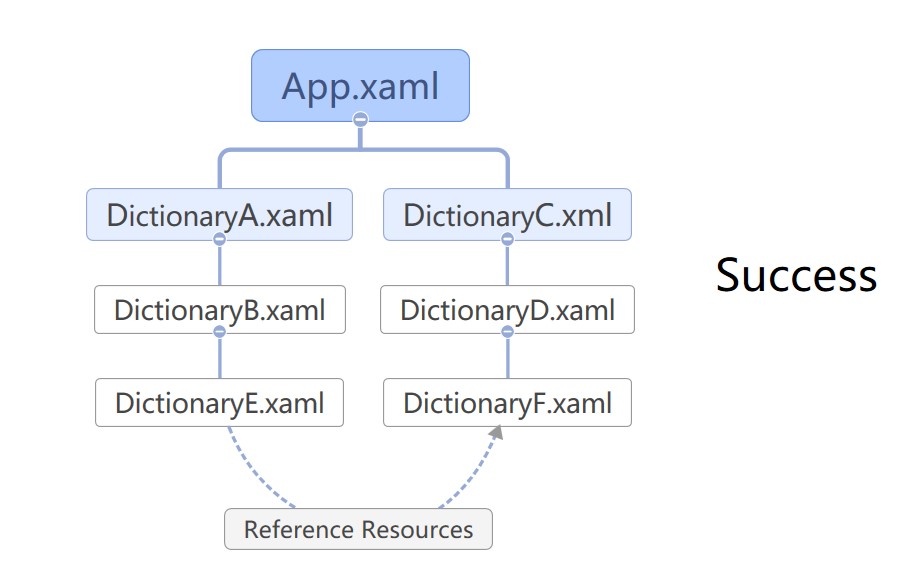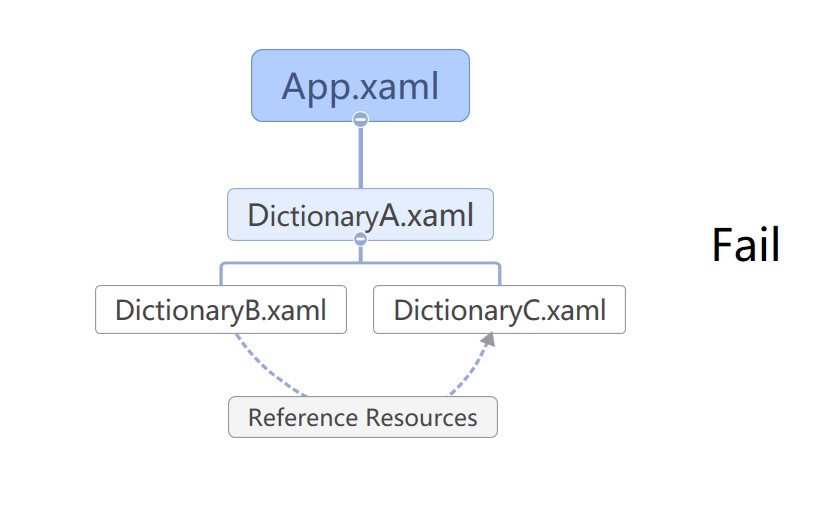大家都知道,在 WPF 里面,可以让资源字典合并其他资源字典,从而定义出资源字典引用树。然而在资源字典引用树里面,如果没有理清关系,将可以作出一个超级复杂的引用关系网。如果在性能优化中,将网断开部分,可能就会出现找不到资源的情况。本文将告诉大家 WPF 的资源字典树在引用和寻找关系上的坑
在开始之前先来演示一下正确的使用方法,也是绝大部分的项目和开发者最常用的方法。 也就是说,如果正常的做,是不会踩到坑的,只有在进行不良设计时才会踩坑
在 App.xaml 里面是作为资源字典的引用的 Root 最顶层,基础玩法都是在 App.xaml 引用其他资源字典,引用顺序基本上基础库,控件库,共用资源,共用样式,业务资源。如果顺序反了,很快就可以在运行应用时找不到资源炸了
例如有 DictionaryA.xaml 和 DictionaryB.xaml 和 DictionaryC.xaml 三个资源字典,在 DictionaryB 里面是共用样式,在 DictionaryC 里面是共用资源。在 DictionaryB 里面的样式引用了 DictionaryC 的资源。此时如果让 DictionaryB 通过 MergedDictionaries 的方式引用 DictionaryC 字典,将存在一个性能问题,那就是在创建资源的时候,如果在 App.xaml 里面也引用了 DictionaryC 那么将让 DictionaryC 被创建两次。一次是在 App.xaml 里面的,一次是在被 DictionaryB 的 MergedDictionaries 创建的,换句话说将会让 DictionaryC 里面的对象重复两次定义,占用资源也添加了启动时间
常用的优化方式就是只在 App.xaml 引用 DictionaryC 即可,不在 DictionaryB 里面加上引用。如果真的需要有设计时帮助,如让 VisualStudio 开启智能(zhàng)提示,那可以使用 d: 设计时资源形式。如此即可让 DictionaryC 只在 App.xaml 里面初始化一份,减少 DictionaryC 的重复创建和减少内存占用,提升了性能
例如在 DictionaryC 里面作为共用资源,定义了画刷资源,如下
<ResourceDictionary xmlns="http://schemas.microsoft.com/winfx/2006/xaml/presentation"
xmlns:x="http://schemas.microsoft.com/winfx/2006/xaml">
<SolidColorBrush x:Key="SolidColorBrush1InC" Color="#565656"/>
</ResourceDictionary>
在 DictionaryB 里面定义了样式,样式需要用到 SolidColorBrush1InC 资源,代码如下
<ResourceDictionary xmlns="http://schemas.microsoft.com/winfx/2006/xaml/presentation"
xmlns:x="http://schemas.microsoft.com/winfx/2006/xaml"
xmlns:d="http://schemas.microsoft.com/expression/blend/2008"
xmlns:mc="http://schemas.openxmlformats.org/markup-compatibility/2006"
mc:Ignorable="d">
<d:ResourceDictionary.MergedDictionaries>
<ResourceDictionary Source="DictionaryC.xaml"/>
</d:ResourceDictionary.MergedDictionaries>
<Style x:Key="ButtonStyleInB" TargetType="Button">
<Setter Property="Background" Value="{StaticResource SolidColorBrush1InC}" />
</Style>
</ResourceDictionary>
在 DictionaryB 里面不会再次合入 DictionaryC 字典,而是统一在 App.xaml 里面将两个资源字典合入。以上代码里面,包含了为了让 VisualStudio 能在设计时帮你找到资源加上的 d: 合并逻辑,这个逻辑不会在运行时有任何作用
在 App.xaml 里面的合入代码如下
<Application x:Class="GeacejalcurnawLarjearemwhear.App"
xmlns="http://schemas.microsoft.com/winfx/2006/xaml/presentation"
xmlns:x="http://schemas.microsoft.com/winfx/2006/xaml"
xmlns:local="clr-namespace:GeacejalcurnawLarjearemwhear"
StartupUri="MainWindow.xaml">
<Application.Resources>
<ResourceDictionary>
<ResourceDictionary.MergedDictionaries>
<ResourceDictionary Source="DictionaryC.xaml"/>
<ResourceDictionary Source="DictionaryB.xaml"/>
</ResourceDictionary.MergedDictionaries>
</ResourceDictionary>
</Application.Resources>
</Application>
合入资源字典是有顺序要求的,如果是先合入 DictionaryB 再合入 DictionaryC 将会在 DictionaryB 里面需要引用资源时找不到资源
System.Windows.Markup.XamlParseException:““{DependencyProperty.UnsetValue}”不是属性“Background”的有效值。”
可以通过如下方式获取本文的源代码,先创建一个空文件夹,接着使用命令行 cd 命令进入此空文件夹,在命令行里面输入以下代码,即可获取到本文的代码
git init
git remote add origin https://gitee.com/lindexi/lindexi_gd.git
git pull origin 6f0ed747acf089095a8503bc8ff967c97efe9de5
以上使用的是 gitee 的源,如果 gitee 不能访问,请替换为 github 的源
git remote remove origin
git remote add origin https://github.com/lindexi/lindexi_gd.git
获取代码之后,进入 GeacejalcurnawLarjearemwhear 文件夹
当然了,对于大部分的开发模型来说,都不会在次级的资源字典里面存放具体的资源或样式等的定义。例如没有在 App.xaml 引用 DictionaryB 资源字典,而是将 DictionaryB 放入到 DictionaryA 里面引用,关系如下

这个引用关系是没有问题的,依然可以在资源字典 DictionaryB 里面找到 DictionaryC 的资源。更新之后的代码放在 github 和 gitee 欢迎访问
那如果继续让 DictionaryC 的实际定义放在更底层呢?例如引入 DictionaryD.xaml 定义的资源呢,引用的关系如下

在 DictionaryC.xaml 的代码变更如下
<ResourceDictionary xmlns="http://schemas.microsoft.com/winfx/2006/xaml/presentation"
xmlns:x="http://schemas.microsoft.com/winfx/2006/xaml">
<ResourceDictionary.MergedDictionaries>
<ResourceDictionary Source="DictionaryD.xaml"/>
</ResourceDictionary.MergedDictionaries>
<SolidColorBrush x:Key="SolidColorBrush1InC" Color="#565656"/>
</ResourceDictionary>
在 DictionaryD.xaml 定义了资源
<ResourceDictionary xmlns="http://schemas.microsoft.com/winfx/2006/xaml/presentation"
xmlns:x="http://schemas.microsoft.com/winfx/2006/xaml">
<SolidColorBrush x:Key="SolidColorBrush1InD" Color="#565656"/>
</ResourceDictionary>
修改 DictionaryB.xaml 的代码,让 DictionaryB.xaml 的 ButtonStyleInB 的背景采用 SolidColorBrush1InD 资源
<ResourceDictionary xmlns="http://schemas.microsoft.com/winfx/2006/xaml/presentation"
xmlns:x="http://schemas.microsoft.com/winfx/2006/xaml">
<Style x:Key="ButtonStyleInB" TargetType="Button">
<Setter Property="Background" Value="{StaticResource SolidColorBrush1InD}" />
</Style>
</ResourceDictionary>
运行程序,可以看到,在进行多级引用时,是可以成功在 DictionaryB.xaml 找到 DictionaryD.xaml 资源。也就是说在不同的两个资源字典树,一个在 DictionaryA 一个在 DictionaryC 字典树上的资源,是可以相互寻找到的
同理,再次提升层级进行测试,结果依然是能找到资源的。再定义 DictionaryE.xaml 和 DictionaryF.xaml 资源字典,让 DictionaryE.xaml 去引用 DictionaryF.xaml 的资源,其引用关系如下

通过以上的测试可以了解到,在去掉 App.xaml 这个 Root 顶层资源之后的多个不同的资源字典树,多个资源字典树的资源是可以被跨资源字典树进行引用的,和存放的层级无关
这也是非常符合预期的,通过这个功能,即可将需要复用的资源分开,减少重复的定义,提升界面资源的模块化
但是又有一项带坑的设计,那就是在除了 App.xaml 这个 Root 顶层资源之后的资源字典树,在资源字典树内是不能跨节点引用。例如以下的关系,将会找不到资源

如上图,在 DictionaryA.xaml 资源字典里面引用了 DictionaryC.xaml 和 DictionaryB.xaml 两个资源字典,代码如下
<ResourceDictionary xmlns="http://schemas.microsoft.com/winfx/2006/xaml/presentation"
xmlns:x="http://schemas.microsoft.com/winfx/2006/xaml">
<ResourceDictionary.MergedDictionaries>
<ResourceDictionary Source="DictionaryC.xaml"/>
<ResourceDictionary Source="DictionaryB.xaml"/>
</ResourceDictionary.MergedDictionaries>
</ResourceDictionary>
依然在 DictionaryC.xaml 里面定义资源
<ResourceDictionary xmlns="http://schemas.microsoft.com/winfx/2006/xaml/presentation"
xmlns:x="http://schemas.microsoft.com/winfx/2006/xaml">
<SolidColorBrush x:Key="SolidColorBrush1InC" Color="#565656"/>
</ResourceDictionary>
在 DictionaryB.xaml 进行引用 SolidColorBrush1InC 资源,代码和上文的一样
<ResourceDictionary xmlns="http://schemas.microsoft.com/winfx/2006/xaml/presentation"
xmlns:x="http://schemas.microsoft.com/winfx/2006/xaml">
<Style x:Key="ButtonStyleInB" TargetType="Button">
<Setter Property="Background" Value="{StaticResource SolidColorBrush1InC}" />
</Style>
</ResourceDictionary>
然而运行将会提示找不到 SolidColorBrush1InC 资源
大家可以尝试一下这个更新之后的代码,更新之后的代码放在 github 和 gitee 欢迎访问
可以通过如下方式获取更新后代码,先创建一个空文件夹,接着使用命令行 cd 命令进入此空文件夹,在命令行里面输入以下代码,即可获取到本文的代码
git init
git remote add origin https://gitee.com/lindexi/lindexi_gd.git
git pull origin 66820e750fb1b5a104b3b4582dd31ac7393439bb
以上使用的是 gitee 的源,如果 gitee 不能访问,请替换为 github 的源
git remote remove origin
git remote add origin https://github.com/lindexi/lindexi_gd.git
获取代码之后,进入 GeacejalcurnawLarjearemwhear 文件夹
也就是说在一个顶层的资源字典,非 App.xaml 哦,这个可不是资源字典,这个字典里面如果同时包含了共用资源和具体的样式,那如果在具体的样式里面用到任何共用资源,将会找不到共用的资源。这个就是本文要来告诉大家的 WPF 的已知问题
对于一些基础库来说,由于特殊的逻辑,不想分开两个资源字典,尽管分开两个资源字典更方便顶层业务层的定制需求,但是由于有特殊的需求而不想分开的,可以将 StaticResourceExtension 换成 DynamicResourceExtension 引用。利用 DynamicResourceExtension 会自动更新的机制,在 App.xaml 初始化资源字典的时候,实际访问将会重新去 App.xaml 寻找,从而找到资源
更改 DictionaryB.xaml 的代码如下
<ResourceDictionary xmlns="http://schemas.microsoft.com/winfx/2006/xaml/presentation"
xmlns:x="http://schemas.microsoft.com/winfx/2006/xaml">
<Style x:Key="ButtonStyleInB" TargetType="Button">
<Setter Property="Background" Value="{DynamicResource SolidColorBrush1InC}" />
</Style>
</ResourceDictionary>
虽然换用 DynamicResourceExtension 在性能上是比不过 StaticResourceExtension 的,但好在如果数量不超过几万项的话,这部分降低的性能很少
这个问题我也报告给了 WPF 官方,请看 The StaticResourceExtension will not find the resources of the ResourceDictionary of the sibling node · Issue #6627 · dotnet/wpf
本文会经常更新,请阅读原文: https://blog.lindexi.com/post/WPF-%E5%B7%B2%E7%9F%A5%E9%97%AE%E9%A2%98-%E8%B5%84%E6%BA%90%E5%AD%97%E5%85%B8%E6%A0%91%E5%BC%95%E7%94%A8%E4%B8%8E%E8%B5%84%E6%BA%90%E5%AF%BB%E6%89%BE%E7%9A%84%E5%9D%91.html ,以避免陈旧错误知识的误导,同时有更好的阅读体验。
如果你想持续阅读我的最新博客,请点击 RSS 订阅,推荐使用RSS Stalker订阅博客,或者收藏我的博客导航
 本作品采用
知识共享署名-非商业性使用-相同方式共享 4.0 国际许可协议
进行许可。欢迎转载、使用、重新发布,但务必保留文章署名林德熙(包含链接:
https://blog.lindexi.com
),不得用于商业目的,基于本文修改后的作品务必以相同的许可发布。如有任何疑问,请
与我联系
。
本作品采用
知识共享署名-非商业性使用-相同方式共享 4.0 国际许可协议
进行许可。欢迎转载、使用、重新发布,但务必保留文章署名林德熙(包含链接:
https://blog.lindexi.com
),不得用于商业目的,基于本文修改后的作品务必以相同的许可发布。如有任何疑问,请
与我联系
。
无盈利,不卖课,做纯粹的技术博客
以下是广告时间
推荐关注 Edi.Wang 的公众号

欢迎进入 Eleven 老师组建的 .NET 社区

以上广告全是友情推广,无盈利

